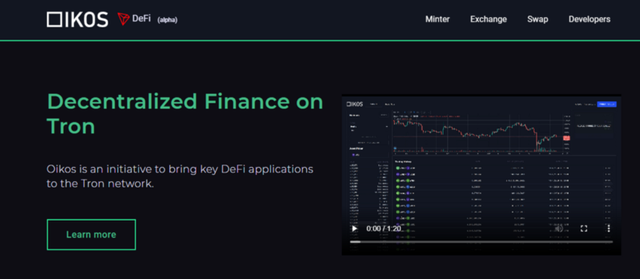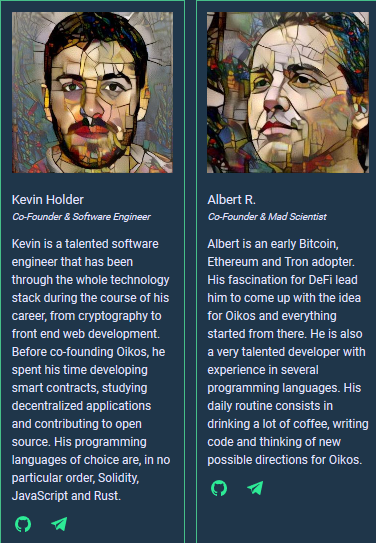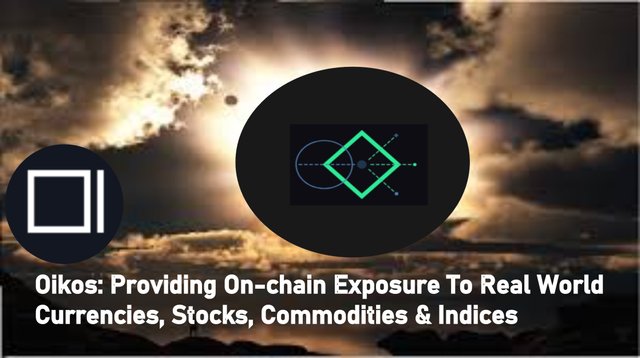Oikos: Providing On-chain Exposure To Real-world Currencies, Commodities, Stocks & Indices
The Oikos Imperatives At A Glance
Oikos is about the epitome of decentralization Synthetic-Asset that is premised on TRON. Oikos Network Token (OKS) fills in as the framework on which these Synthetic-Asset are utilized as collaterals which when secured in the contract ensures the issuance of synthetic assets otherwise known as Synths. This collected security model empowers clients to perform changes between Synths directly with the Smart-Contract keeping away the requirement for counterparties. Oikos presently accommodates synthetic monetary standards, cryptographic forms of money (long and short), and commodities. In order to create a kind of reward; incentives are easily handy to OKS holders to stake their tokens as they are paid in proportion to the accumulation of cash created through movement on Oikos.Exchange, in view of their commitment to the system. To exchange on Oikos.Exchange doesn't require the expected trader in any way to possess OKS.
The OKS Inflation Model:
OKS adopts an inflation model. In 4 and a half years, its supply will increase from 100 million to 260 million. Part of the additional tokens will be issued in return to those who provide liquidity on Oikos Swap. In addition, users who pledge OKS can also receive Oikos Exchange transaction fee rewards.
Due to the mechanism of liquid mining and the early rise of OKS in the secondary market, Oikos has attracted a large number of users to buy and pledge OKS for mining. According to data released by Oikos on June 29, its agreement locked up nearly 30 million OKS; on the other hand, after OKS was first launched on the Hufu Exchange, it also launched more than 20 trading platforms such as BiKi. The wealth effect of rising prices Attracted many investors to buy.
THE OIKOS SWAP:
The Oikos Swap is basically an exchange platform specially designed for TRON. It is a trustless decentralised exchange technique seamlessly built to allow participants to commit any withdrawal or deposit devoid of the traditional centralization. Basically, the order book is modeled to exchange any token of TRC
Taking a look at the exchange page, you can find that Oikos mainly supports the exchange of several currencies under TRON, such as TRX, JST (TRON stable currency), sTRX, etc., and also includes USDT.
Oikos that is fundamentally TRON based, should have a good relationship with his parents, TRON.
Why Oks Holders Participate In Shares

Possessors of the OKS deploy tokens that belong to them and mint synths in diverse ways. First, as long as someone exchanges one Synth interchangeably, in other words, incentives will be generated. Taking a cursory look at other incentives for OKS holders to engage in bet and mint is basically the OKS reward for bets, this actually emanates from the inflationary financial procedure of the accord.
Mortgage, debtor and merger counterparty
OKS stakeholders create ”debts” when they create Synths. According to the exchange rate and supply of Synths in the network, the debt may increase or decrease independently of its original casting price. In this way, OKS risk-takers become the collective counterparty of all Synth exchanges.
Synthetic Pinning Mechanism

Arbitrage: OKS risk-takers increase the debt by casting the known Synths, in other words, should the pegged exchange price goes down, it possible for them to make a profit by simply buying back
the sUSD underneath the set value and burning it to reduce debt.
STRX Liquidity Pool On Oikos Swap: Part of the OKS added to the total supply through monetary policy every week as a reward for people on Oikos Swap.
OKS Auction: Oikos is currently adopting a new mechanism in which discounted OKS is sold in TRX auctions.
Understanding The OIKOS Processes:

First, go to dapp 0 to exchange trx to get oks;
Take the oks obtained in the No. 0 dapp and go to the No. 1 dapp to mortgage to generate synthetic assets;
Then put the synthetic assets generated by mortgage oks in the No. 1 dapp to the No. 2 dapp to make a transaction.
It is understandable to exchange oks on the 0th, You can also go to the 1st to generate synthetic assets, and then go to the 2nd to do synthetic asset transactions? So, to put it simply, it is an asset symbol that anchors an asset outside the system. It can be anchored to Bitcoin or gold.
For example, you pledge $750 worth of oks to generate a synthetic asset sUSD worth $100. This sUSD is a system stable currency anchored to the US dollar.
So, why do you need to exchange oks for synthetic assets? In this way, you can borrow dollars from the system to participate in the long-short game of various tokens or other assets in the market, regardless of the price of the oks itself, without selling the oks.
Then we continue to explain the operations in the No. 2 dapp and figure out how to complete this decentralized long-short game. In dapp No. 1, the synthetic asset minted is sUSD, which is a stable currency. By the dapp No. 2, you can use sUSD to trade into various tokens such as Bitcoin.
The Team:

The Oikos team to say the least have inspired a good number of us, despite attempts to ridicule and defame the project, it has remained a phenomenal project with a proficient and result-oriented value proposition that will change the global decentralized structure. Rhe Oikos team is vastly experienced individuals and digital minds that are well acquainted with the dynamics. They have been instrumental for the success of the template offered by the Oikos project.
For more info click below:
Official website: ttps://oikos.cash/
White paper: https://docs.oikos.cash/litepaper-zh.pdf
Github: https://github.com/orgs/oikos-cash/
Twitter: https://twitter.com/oikos_cash
Telegram: https://t.me/oikoscash
Bitcointalk Username: Globen
Bitcointalk Profile Link: https://bitcointalk.org/index.php?action=profile;u=2515607
